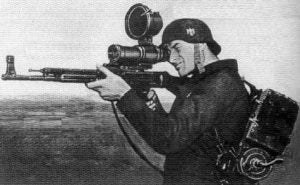Written by guest contributor Richard Douglas.
Night vision is very old tech. Most night vision optics use analog image intensifier tubes — technology that existed ever since the 1930s. In fact, this is the same fundamental technology that the marines used in the Battle of Okinawa (1945). That said, technology has come a long way since then. And now, it’s gotten so good (and affordable) that it can even be used as an AR-10 scope
Which night vision device should you choose? By the end of this guide, you’ll find the right generation of night vision for you.
Let’s get started!
Gen 0 Night Vision

This generation is the ‘father’ of modern night vision. It is what soldiers used in World War II—basically, a big infrared searchlight to see in the dark. This huge searchlight was too heavy and impractical for common deployment. That’s why you can’t buy it. Instead, they developed…
Gen 1 Night Vision

In Vietnam, the military started using Gen 1 night vision optics. It was lighter, the light sensitivity was better, and it worked in very close-range applications. The result? It was the first usable night vision on the market. But is it the right night Gen for you? To find out, let’s break down its pros, cons, and how it looks:
Pros
- Very cheap
- Great for light usage
Cons
- Not very clear
- ‘Fish-eye’ lens effect
- Blooming or ‘halo effect’ around visible light sources
- Shorter lifespan (1,500 hours)
- Short distance—100 yards maximum range
- IR illuminator gives off position to others
Best Use:
If you’re just getting started or a hobbyist, then Gen 1 night vision is for you. It’s cheap and helps you see in the dark in very close-range applications (up to 50 yards).
That said, if you are a little more serious, then go for…
Gen 2 Night Vision

Gen 2 arrived in the late 70s. An added microchannel plate allows the night vision optic to be used without extra infrared illumination. This made Gen 2 night vision the first ‘lightweight’ tactical night vision solution. It changed nighttime warfare forever and it’ll probably change your nighttime hunts, too.
Let’s break it down:
Pros
- Affordable, quality night vision
- Doesn’t need an IR illuminator to work (although it has one)
- Improved image quality
- Longer lifespan (2,500 – 5000 hours)
Cons
- Lacks image clarity
- Medium range applications (up to 200 yards)
- Can cost as much as Gen 3
Best Use:
Either nighttime hunting or medium-range application (up to 200 yards) is best for Gen 2. It’s decent for the price. However, if you’re looking to step it up to the very best, then go for…
Gen 3 Night Vision

This is the latest Gen night vision on the market. It originally arrived in the 80s. For Gen 3, a gallium arsenide photocathode (or an upgraded tube) was added. As a result, you can now see almost everything in the dark. But is it worth the extra money?
To find out, let’s break it down:
Pros
- Highest quality night vision
- Great low-light performance
- Doesn’t need an IR illuminator
- Longest lifespan (10,000+ hours)
- Goes to 300 yards and beyond
- Can be used day or night
Cons
- Very expensive ($1,000+)
Best Use:
It’s best used for serious tactical and long-range applications (up to 300+ yards). To put it simply, Gen 3 is the very best, but it does cost a pretty penny. Sometimes going well above the $2,000 price range!
If Gen 2 or 3 are still too expensive for your budget but you don’t want to sacrifice quality or clarity, you’ll probably love…
Digital Night Vision

Digital utilizes the fundamental technology of night vision (photocathode tubes) and improves it by using modern silicon chips to display the image—similar to a digital camera.
The result?
An affordable optic that performs between Gen 1 to Gen 2 in night vision functionality, which is also completely safe to use during the day. Here’s the breakdown:
Pros
- Very affordable
- Can be used day or night without breaking the unit
- Reliable (as it doesn’t burn out easily)
- Can record video
Cons
- Not combat-tested yet
How It Looks:
Sightmark’s Wraith high-quality digital scope (MSRP $599.99) mixes expensive night vision tech and a magnified riflescope all in one. It is also affordable and reliable.
Here’s a video of Sightmark’s Wraith HD Digital Riflescope in-action:
Impressive, isn’t it? With that said, here’s the…
Best Use
Digital day/night vision scopes are for the smart hunter that hunts day and night and shoots up to 200 yards.
So now that we’ve got the night vision generations out of the way, it’s time to address the final question on many people’s minds…
Green or White Phosphor Technology

Here’s the truth—both do the same job. There’s no scientific evidence showing one is better than the other. It honestly just boils down to preference. If you like how green phosphor looks, then go for it. Likewise, if you like white phosphor (which looks a bit more natural) go with that. It doesn’t matter. What matters is the resolution of the night optic. So, make sure you spend money on a quality, high-resolution optic rather than going for some fancy phosphor color.
And that’s all there is to night vision. With what you’ve just learned so far…
What Night Vision Technology Will You Choose?
Maybe Gen 2 or the more affordable digital night vision? Either way, let me know in the comments below.
About Richard
Richard Douglas is the founder of Scopes Field, a blog where he reviews the best scopes and guns on the market. He’s been featured on various magazines and publications like Daily Caller, Burris Optics, SOFREP, Boyds Gun Stocks, Talon Grips, American Shooting Journal and so much more.
Frequently Asked Questions
What are the differences between Gen 0, Gen 1, Gen 2, and Gen 3 night vision?
Gen 0 used bulky IR searchlights and is obsolete. Gen 1 offers affordable close-range visibility but suffers from low clarity and short lifespan. Gen 2 improves clarity and works without IR, ideal for mid-range use. Gen 3 provides superior image quality and long-range performance, but at a higher cost.
Is digital night vision better than Gen 1 or Gen 2?
Digital night vision performs between Gen 1 and Gen 2 levels but adds features like video recording, daytime use, and long-term reliability. It’s a great alternative for those on a budget who still want good clarity.
Can digital night vision be used during the day?
Yes. Digital night vision like the Sightmark Wraith is safe to use in full daylight without damaging the optic, unlike analog tubes that can be ruined by sunlight exposure.
What is the effective range of each night vision generation?
Gen 1 is effective up to 100 yards (best under 50), Gen 2 reaches around 200 yards, and Gen 3 can exceed 300 yards. Digital night vision generally performs well up to 200 yards, depending on conditions.
What’s the difference between green and white phosphor night vision?
Green and white phosphor provide the same performance. Green is traditional, while white offers more natural contrast. Choosing one is a matter of personal preference—not performance.
How long do night vision devices typically last?
Gen 1 devices last around 1,500 hours, Gen 2 can last 2,500–5,000 hours, and Gen 3 exceeds 10,000 hours. Digital scopes don’t degrade the same way and can last even longer with proper care.
What is the best night vision option for hunters?
For budget-conscious hunters, digital night vision offers excellent day/night flexibility. Gen 2 is great for mid-range night hunts, while Gen 3 is ideal for serious, long-range nighttime use.



